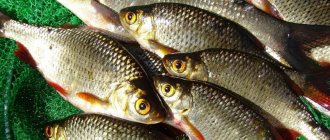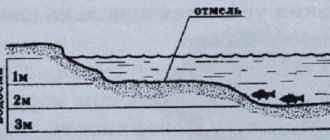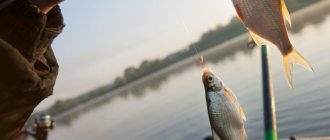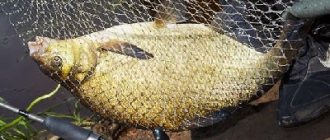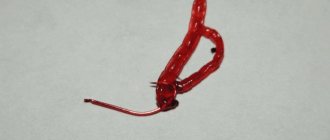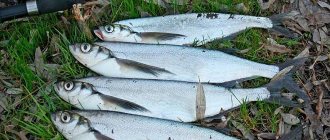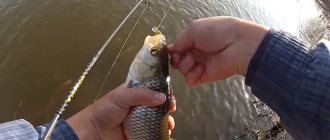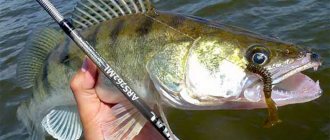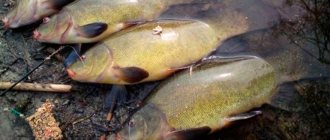In spring, as well as in summer and autumn, roach is caught well with bottom tackle, in particular with a feeder and a lighter picker. Since in the spring the roach comes quite close to the shore, there is no need to cast the feeder very far. Usually the roach stands near the shore, so the tackle should be quite light.
Starter feeding is best done with large-capacity feeders. That is, you need to make ten to fifteen feeding casts, and then attach a leash to the rig and start fishing.
Many experienced fishermen use light feeder feeders, or even streamlined sinkers. This is explained by the fact that light loads create a smaller splash on the water, which scares the fish less in the fishing area.
Tackle for catching roach on a feeder
The rod and reel must match each other, and if we fish at a short distance from the shore and use light loads, then it is advisable to select rods that are not very long (3-3.6 meters) with a small weight (10-50 grams). The optimal coil size is 2000-3000. As a fishing line, it is advisable to use a thin braided cord with a fluorocarbon leader (0.1mm).
The feeder can be attached to the main line in the most common ways: Gardner loop, asymmetrical, symmetrical loop and anti-twist tube. On rivers, it is advisable to use mesh metal feeders of rectangular or triangular shape.
For feeder fishing in still water, you can use feeders of any shape and material, the main thing is the degree of its openness, since the bait should be well washed out of the feeder even in the absence of a current.
The weight of the feeder should be as small as possible, but so that the feeder does not blow away. Light feeders sink less into the silt, and the tackle turns out to be lighter and more sensitive.
Feeder rig for roach in spring
Rod
Catching roach on a feeder in the spring does not require long casts, so small rods of 3-3.9 meters are taken. For targeted fishing at a picker distance (up to 15 m), you can use shorter blanks of 2.1-2.7 m. The test of the feeder rod will depend on the fishing conditions; often middle-class rods with a test weight of up to 90 grams are used on the river. These rods can also be used on standing reservoirs, equipped with lighter feeders.
There are times when we have to fish in conditions of strong currents and here we cannot do without heavy-class rods with a test weight of 120-150 grams; with such coarse gear, it makes sense to catch only large roach.
In a still body of water, fish are always more lethargic and timid, so here it is better to use light-class rods with a weight of up to 50 grams.
Don’t forget about the presence of sensitive feeder tips; after all, the roach is a small fish.
Coil
A small inertia-free reel will be sufficient, spool size 2000-3000. Since roach is not large in size, the reel should be fast, not powerful.
Only when fishing in strong currents, more powerful reels with a spool size of 3000-4000 are used.
fishing line
On standing reservoirs with a distance of up to 30 m, a thin monofilament line with a diameter of 0.16-0.12 mm is used. In the current or with a casting distance of more than 30 m, install braid with a thickness of 0.1-0.12 mm.
The monofilament line is 0.02 mm thinner than the main line. To catch cautious roach, you can use fluorocarbon leashes, which are less noticeable than the main line. The length of the leash for the feeder depends on the intensity of the bite; it is better to start with longer leashes; if during the fishing process you take out an empty hook, but the bite was not visible or the caught fish swallows it heavily, then you need to reduce the length of the leash.
Hooks
To catch roach on the feeder in the spring, thin hooks No. 15 - 18 according to the international classification are used. Thin hooks make it much easier to string bloodworms.
Feeders
For standing ponds, plastic feeders of the method and mesh type are used; plastic feeders rise much better when reeled out.
In the current, closed metal feeders are used; they have more weight with less volume, which is why they are more stable.
Equipment
Works well in current
- Inline;
- Paternoster;
- Symmetrical loop;
- Asymmetrical loop
In low currents and still water:
- Paternoster;
- Inline;
In early spring, you should pay attention to equipment that does not have a self-trimming function, but has greater sensitivity (paternoster and inline). Read about the rules for installing equipment here .
Finding Roach Places
In the spring, roaches gather in well-warmed areas, that is, in shallow water and grassy areas, where they feed on insect larvae and the eggs of other fish species. For successful fishing, it is very important to choose the right place. If you have to fish in stagnant bodies of water, then it is advisable to cast the bait a little further than the feeding point, and then reel it in with a rod or reel.
Strong wind can have both a positive and negative effect on fishing, because the wind can interfere with accurate casting, but a breaking wave can bring food to the shore, which attracts fish. So experienced fishermen prefer to catch roach against the wind.
It is also worth noting that if the roach stops pecking from the bottom, then you need to try to catch it in other layers of water. Roaches often rise to the surface in search of food.
In the late evening and early morning, roaches have to be caught close to the shore near the algae. The optimal depth for catching roach in the spring on a feeder is 2-3 meters.
You can go to Akhtuba for a good catch, because fishermen from those places constantly boast of solid catches, which is not surprising, because Astrakhan is famous for its many lakes, water channels and islands. There is plenty of fish here all year round, which is why fishing in the Astrakhan region is considered very productive. Plus, there are a lot of fishing bases in Astrakhan where you can not only go fishing, but also relax with the whole family.
How to catch roach on a feeder in the spring?
It is quite common to see fishermen using two or more rods at the same time. This suggests that they either use the wrong fishing technique, or they are simply unlucky with the bite, but hope does not leave them. In fact, if you catch roach using the correct method, one rod will be enough, because you need to have time to cope with it.
Conventionally, catching roach in the spring on a feeder can be divided into two steps:
- Initial feeding of the proposed fishing spot. At this stage, you need to make ten to twenty casts exactly to the place where you plan to fish in the future;
- Regular fishing. This stage involves fishing with re-casting the rod every five minutes, if there was no bite before.
Now let's break it down:
- So, the first thing you need to make sure is that spring roach fishing on a feeder is as effective as possible - in the correctly chosen bottom topography. Ideally, this should be either a flat surface or a depression, but not any rise. You can check the condition of the bottom using a weight and a float by dragging it to the bottom. On a flat surface it moves easily and without difficulty;
- Having done this, you need to unwind a line one and a half meters long and secure the rod in a position comfortable for fishing. It is not advisable to change it, so it is better to do everything efficiently the first time. Next, we begin to throw the feeder at the same point, without changing it in any way. As a reference point, you can choose some object on the opposite side of the reservoir;
- It is very important to constantly cast the feeder to the same point as before, and this must be done without a hook with a leash. We do this fifteen times. After casting with a smooth movement, preferably from behind your back, immediately fix the rod on the mount. It is necessary that the feeder always falls in the same place and is at the same distance from the tip of the rod;
- Catching roach in the spring on a feeder involves careful and thoughtful actions, the most important of which are the starting ones. These casts play a vital role; they must be performed in such a way that as many fish as possible accumulate in the chosen place. To do this, wait ten seconds after each cast and pull out the feeder with a sharp movement. This way the bait will remain in the right place;
- When the starting casts are made, you need to attach a line and a hook to the rod. We hook a maggot or worm onto it, make a careful cast to the same point and fix the rod on the holder, putting a medium tension on the line;
- If the roach does not bite on the filler for more than five minutes, check the presence of bait on the hook by pulling out the feeder. If necessary, fill it again and cast. When the fish bites, the tip of the rod noticeably reaches towards the water, then you need to make a smooth and amplitude hook, but sometimes you need to work sharply. To remove the fish from the water, continue to make gentle and smooth movements until you achieve the desired result.
Catching roach in spring on a feeder (video)
Catching roach on a feeder in spring: video
Spring roach fishing on a feeder: video from a reservoir
What to use to catch roach in spring
In early spring, bloodworms are considered the best bait for roaches. You need to bait several larvae on the hook at once. It is also worth trying to catch maggots and dung worms. To cut off small fish, you can try using pearl barley. Also, do not forget about the so-called sandwiches - combinations of baits. For example, bloodworms + maggots or worms + maggots.
Roach can also be caught on multi-colored foam balls. It has been observed that the most effective color of foam balls is yellow. The ball must be pierced completely, leaving the sting open. Another promising bait for roach is dough.
Tactics for spring roach fishing with a feeder
Fishing for spring roach on a feeder will be effective only if the fisherman is able to correctly plan fishing tactics and select the optimal leash length and working bait.
Finding a fishing spot
In early spring, schools of roach on the river are more often found near the channel edges, in areas with a hard bottom and a depth of about 4–5 m. You can quickly find such places using a marker weight attached to the end of the feeder equipment.
In the second half of April, river roach enters shallower areas and begins to feed on stretches with a slow current and a depth of about 3 m. In May, look for the roach in creeks and bays.
When fishing for roach in a vast area of stagnant reservoirs, you should not rush to feed the point. In late April and May the fish are active on the move, so look for a feeding school first.
Having placed bait on the hook, but without filling the feeder, cast the rig at an angle of 30–45 degrees to the water's edge and begin slow reeling, while making minute pauses every 5 m. If a bite occurs during a stop, the line is clipped to the reel spool and fed promising point.
Working with leashes and baits
In early spring on the river, roach usually feeds near the very bottom, so the leash length should be 40–60 cm. The most effective bait at this time is bloodworm. In April, the results are shown by a combination of 2 bloodworms and one maggot.
At the end of April, in stagnant reservoirs, roach begins to respond well to the bait slowly descending in the water column.
In this case, the optimal leash length will be 70–100 cm. If in early spring the sorog gave preference to bait of animal origin, then with the arrival of May it begins to show interest in plant types of bait:
- semolina mash;
- rolled oats;
- boiled pearl barley.
In May, there are situations when roaches begin to feed in the upper layers of water. In this case, the feeder will have to use a little secret, which is that the length of the leash is increased to one and a half meters, and a small foam ball is placed on the hook, which gives the bait positive buoyancy.
Roach bait recipe
- Ingredients for catching roach:
- 500 grams bran
- 500 grams breadcrumbs
- 400 grams of corn porridge
- glass of oatmeal
- 4 tablespoons milk powder
- a tablespoon of sugar + a packet of vanillin.
The amount of flavorings added to the bait depends on the water temperature. The colder the water, the more odorous substances we add. But try not to overdo it, as bait that is too aromatic can simply scare away the roach from the fishing spot.
